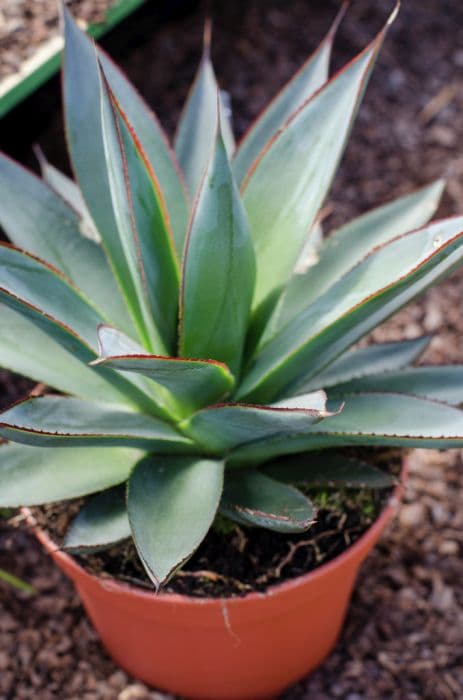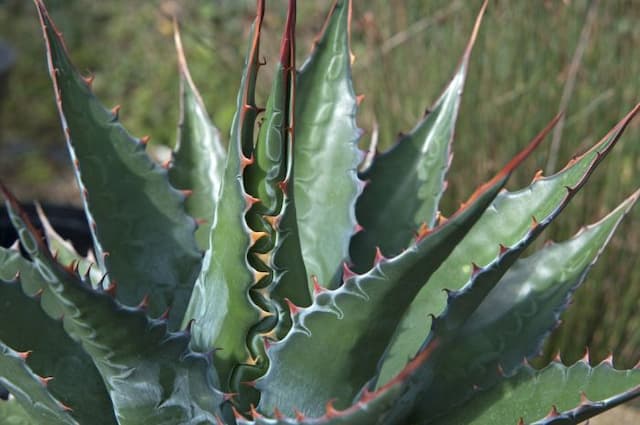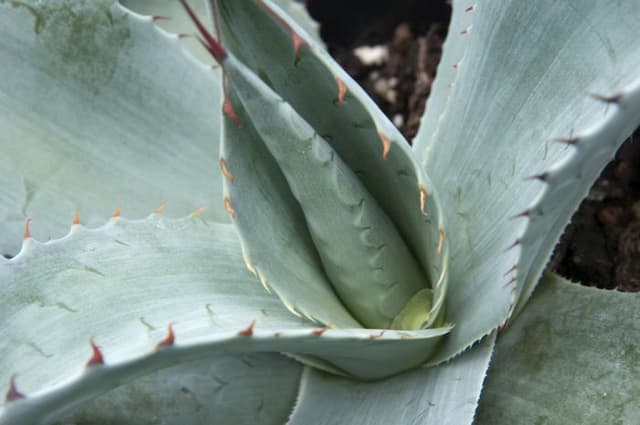Blue Angel Hosta Hosta 'Blue Angel' (sieboldiana)

ABOUT
Hosta 'Blue Angel' is a striking perennial known for its lush foliage and shade tolerance. The plant features large, heart-shaped leaves that exhibit a stunning blue-green color, giving it a distinct appearance in any garden. The leaves are heavily corrugated with a prominent vein structure that adds texture and visual interest. As the leaves mature, they may develop a slightly wavy edge, adding to the plant's overall charm. During the blooming period, which often occurs in mid to late summer, the Hosta 'Blue Angel' sends up tall flower scapes that are adorned with bell-shaped flowers. The flowers are typically a soft lavender to white color and are known to attract bees and other pollinators. These flower stalks rise gracefully above the foliage, adding a splash of vertical interest without overwhelming the plant's leafy display. The Hosta 'Blue Angel' is appreciated for its mounding, clump-forming habit that creates a substantial presence in the landscape. Its robust nature and impressive leaf color make it an excellent choice for adding a soothing cool tone to shaded garden areas or for creating a contrast with plants that have lighter or more vibrant foliage. The plant is easy to care for and is commonly used in borders, as a ground cover, or as an accent plant in woodland settings.
About this plant
 Names
NamesFamily
Asparagaceae
Synonyms
Plantain Lily, Funkia, Hosta
Common names
Hosta sieboldiana 'Blue Angel'.
 Toxicity
ToxicityTo humans
Hosta 'Blue Angel' is commonly known as hosta. This plant is not considered highly toxic to humans. However, if ingested in large amounts, it may cause mild stomach upset. Typical symptoms of eating parts of the plant could include nausea, vomiting, or diarrhea. In general, the plant is unlikely to cause severe poisoning in humans, but it's always advisable to avoid eating ornamental plants.
To pets
Hosta is considered toxic to pets, including cats and dogs. If a pet ingests any part of a hosta plant, it could lead to symptoms such as vomiting, diarrhea, and in rarer cases, depression. It's important for pet owners to prevent their animals from eating this plant to avoid potential health issues. If a pet has consumed hosta and is showing troubling symptoms, contacting a veterinarian is recommended.
 Characteristics
CharacteristicsLife cycle
Perennials
Foliage type
Deciduous
Color of leaves
Blue-green
Flower color
Lavender
Height
3 feet (91 cm)
Spread
5 feet (152 cm)
Plant type
Herb
Hardiness zones
3
Native area
Asia
Benefits
 General Benefits
General Benefits- Shade Tolerance: Hosta 'Blue Angel' thrives in shaded areas of the garden where other plants may struggle.
- Aesthetic Appeal: With its large, heart-shaped blue-green leaves, it adds texture and a cooling effect to garden spaces.
- Low Maintenance: It is a low maintenance perennial, requiring minimal care once established.
- Attracts Wildlife: Its flowers can attract hummingbirds and bees to the garden, enhancing biodiversity.
- Erosion Control: The widespread root system can help prevent soil erosion by stabilizing the soil in the garden.
- Ground Cover: The dense foliage can act as a living mulch, suppressing weed growth and retaining soil moisture.
- Garden Design Flexibility: Works well in a variety of garden designs, including borders, woodland gardens, and as a specimen plant.
- Seasonal Interest: Offers visual interest from spring to fall with foliage and summer blooms.
- Winter Hardiness: It is cold-tolerant, surviving well in winter months in many climates.
- Drought Resistance: Once established, it can withstand periods of drought with less frequent watering.
 Medical Properties
Medical PropertiesThis plant is not used for medical purposes.
 Air-purifying Qualities
Air-purifying QualitiesThis plant is not specifically known for air purifying qualities.
 Other Uses
Other Uses- Leaf Mulch: Hosta 'Blue Angel' leaves can be used to create nutrient-rich leaf mulch for garden beds, as they break down over time and enrich the soil.
- Mixed Borders: This plant can add texture and color variation when used in mixed borders with other shade-loving perennials and shrubs.
- Garden Sculptures: Large Hosta 'Blue Angel' leaves can be used as natural molds for making concrete garden sculptures due to their size and shape.
- Backdrops for Flowering Plants: The broad, blue-green foliage provides an excellent backdrop for highlighting the colors of flowering plants.
- Photography Prop: The large, attractive leaves can be used as a natural backdrop or prop in plant photography to enhance the composition.
- Water Garden Accent: Although not a water plant, Hosta 'Blue Angel' can be planted around water gardens to add foliage interest without the need for direct water contact.
- Theme Gardens: Hosta 'Blue Angel' can be a part of a "blue" themed garden, playing on the blue hue of its leaves among other blue flowers and plants.
- Container Gardening: With its substantial growth size, it can be grown in large containers to add greenery to patios or balconies with shade.
- Plant Castings: The large leaves can be used to create decorative plant castings in plaster or cement for artistic garden elements.
- Living Screens: When planted in a row, Hosta 'Blue Angel' can create a semi-dense, living screen to provide privacy or hide unsightly areas in the garden.
Interesting Facts
 Feng Shui
Feng ShuiThe Hosta plant is not used in Feng Shui practice.
 Zodiac Sign Compitability
Zodiac Sign CompitabilityThe Hosta plant is not used in astrology practice.
 Plant Symbolism
Plant Symbolism- Resilience: The Hosta, also known as plantain lily, is known for its hardiness and ability to thrive in shade, symbolizing resilience and the ability to withstand adversity.
- Devotion: With its lush foliage and tendency to grow in clumps, plantain lilies can symbolize devotion and loyalty, characteristics attributed to how they stay robust and multiply in the right conditions.
- Strength: 'Blue Angel' is a larger variety of Hosta, which may be seen as a symbol of inner strength and stability due to its substantial size and presence in the garden landscape.
- Peace and Tranquility: The broad, blue-green leaves of the 'Blue Angel' Hosta evoke a sense of calm and serenity, making it a symbol for peace and tranquility in a garden setting.
- Longevity: Hostas are perennials that can live for many years, symbolizing long life and enduring presence.
 Water
WaterThe Hosta 'Blue Angel', commonly known as Blue Angel Hosta, requires consistently moist soil, so it's essential to water it deeply every week with about 1 inch of water. During periods of drought or extreme heat, increase the frequency to twice per week, ensuring you're providing enough water to soak the soil thoroughly. Avoid overhead watering to prevent leaf disease and instead water at the base of the plant. In the heat of summer, you may need up to 2 gallons per week for each plant to maintain proper moisture levels.
 Light
LightBlue Angel Hosta thrives in partial to full shade, so the ideal location is under the canopy of trees or on the north side of a building where it can be protected from direct afternoon sun. Bright, indirect light will help the plant maintain its vibrant foliage color without causing leaf scorch from excessive sun exposure.
 Temperature
TemperatureBlue Angel Hostas perform best in temperatures between 50°F and 75°F. They are hardy in USDA Zones 3 through 8, meaning they can withstand minimum temperatures down to -40°F to -30°F. These plants prefer cooler climates and might struggle in temperatures consistently above 85°F, making them less suitable for hot, southern regions.
 Pruning
PruningPrune Blue Angel Hosta in late fall or early spring to remove any dead or damaged leaves and promote healthy new growth. Pruning can also be done to shape the plant or control its size. Pruning is typically performed once a year, but you may remove spent flower stalks as needed to improve appearance.
 Cleaning
CleaningAs needed
 Soil
SoilThe best soil mix for Hosta 'Blue Angel' is rich, well-draining soil with a pH between 6.5 and 7.5. A mixture containing one part garden soil, one part compost or well-rotted manure, and one part perlite or vermiculite is ideal. Mulching the plant will help maintain moisture.
 Repotting
RepottingHostas, including 'Blue Angel', generally don’t need frequent repotting and can thrive for several years in the same spot. However, if growth is stunted or the roots are overcrowding, repot in the spring every 3-5 years.
 Humidity & Misting
Humidity & MistingHosta 'Blue Angel' prefers average to high humidity levels. While typical garden humidity is usually adequate, ensure the plant is not in an overly dry environment to promote healthy growth.
 Suitable locations
Suitable locationsIndoor
Keep 'Blue Angel' Hosta in bright, indirect light and cool temps.
Outdoor
Plant 'Blue Angel' Hosta in shade, with moist, rich soil.
Hardiness zone
3-9 USDA
 Life cycle
Life cycleHosta 'Blue Angel' begins its life cycle when seeds are sown or when rhizomatous divisions occur. The seeds germinate, and the plant begins as a sprouting seedling, establishing roots and early foliage. The Hosta 'Blue Angel', being a perennial, then enters a vegetative state each year with the emergence of broad, blue-green leaves that unfurl from tight buds in the spring. During the summer, the plant matures and produces tall stalks with bell-shaped, pale lavender flowers that attract pollinators. After blooming, the plant enters a period of senescence in the fall where the foliage dies back with the onset of colder weather. Finally, it overwinters in a dormant state, with its rhizomes storing energy to begin the next life cycle phase in the following spring.
 Propogation
PropogationPropogation time
Late spring to early summer
The Hosta 'Blue Angel', commonly known as Hosta or Plantain Lily, is best propagated by division. This method entails separating a mature plant into smaller sections, each with a portion of the root system intact. The ideal time to propagate Hostas by division is in early spring or early fall when the plant is not actively growing. To propagate by division, carefully dig up the entire plant, making sure to minimize damage to the roots. Wash the soil off the roots if necessary to see the natural divisions. Using a sharp, clean knife or spade, cut through the root ball to create sections, each with at least two to three shoots and a corresponding section of roots. These new divisions can then be immediately planted in the garden at the same depth they were originally growing, spaced about 30 to 36 inches (approximately 76 to 91 cm) apart, to accommodate their mature size and allowing them to establish before extremes of cold or heat stress the plants.









